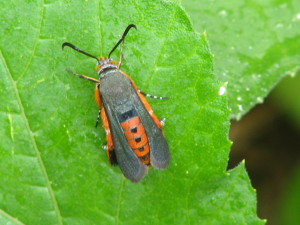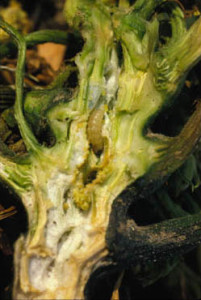
This is the moth phase of the garden pest, Squash Vine Borer.
Have you seen this moth flitting around your squash plants? Look closely. It is has a greenish black top wing and transparent, black-veined bottom wing and is often confused with a wasp. It buzzes when it flies. Unlike most moths, it flies in the daytime.
The Squash Vine Borer, Melitta curcurbitae, is a serious pest of vine crops, commonly attacking summer squash, winter squash, and pumpkins. Cucumbers and melons are less frequently affected.

The Squash Vine Borer larvae make a hole near the base of the stem and crawl inside to feed for 4-6 weeks.
Soon after emerging, squash vine borers lay flat, brown eggs singly at the base of susceptible plants. Approximately one week after they are laid, the eggs hatch and the larvae bore into stems to feed. The larvae feed through the center of the stems, blocking the flow of water to the rest of the plant. The larvae feed for four to six weeks, then exit the stems and burrow about one to two inches into the soil to pupate. They remain there until the following summer. There is one generation per year.
The best thing to do is intervene before eggs hatch and larvae bore into the vines. You may find that placing a yellow container of water may attract and trap the adult Squash Vine Borers. If larvae have already taken up residence, some sources recommend slitting the stem of affected plants and killing the larvae. After extracting the larvae, cover the opening with damp soil and keep it watered. Hopefully roots will develop and the plant may survive.
Promptly pull and destroy any plants killed by squash vine borers. You do not want the larvae to enter the soil under your squash plants only to emerge next year as moths.
